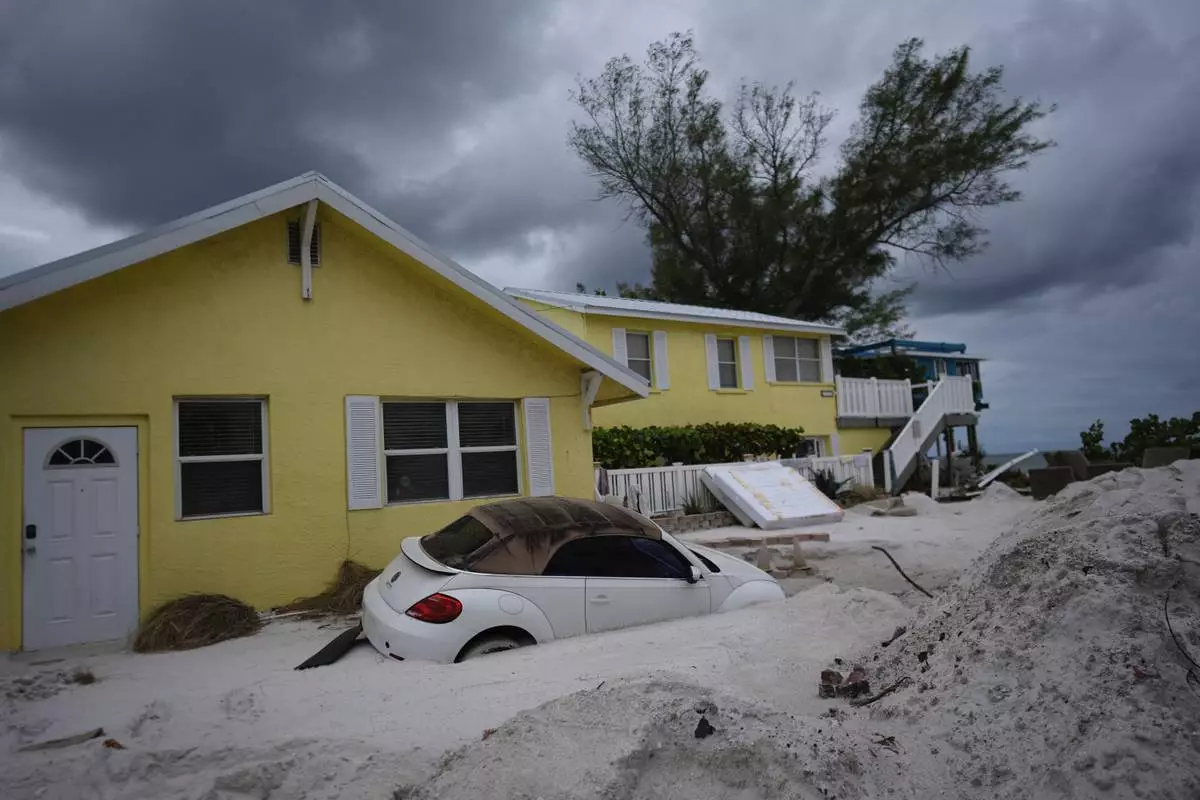NEW YORK (AP) — After months of dozens of restaurant closings and headlines about “endless shrimp” woes, Red Lobster is poised to soon exit from Chapter 11 bankruptcy protection.
A U.S. bankruptcy judge on Thursday approved the casual seafood chain's reorganization plan and sale to a lender group led by asset manager Fortress. The green light arrives under just four months after Red Lobster filed for bankruptcy protection as it pursued a sale, following years of mounting losses and dwindling customers while it struggled to keep up with competitors.
At the time of filing in May, Red Lobster's leadership shared plans to “simplify the business” through a reduction of locations. The Orlando, Florida, chain shuttered dozens of its North American restaurants in recent months — both leading up to and during the bankruptcy process. That includes more than 50 locations whose equipment was put up for auction just days before the Chapter 11 petition, followed by dozens of additional closures throughout the bankruptcy process.
Red Lobster said Thursday that it expects to operate about 544 locations across the U.S. and Canada upon emerging from bankruptcy. That's down from 578 disclosed as of May’s filing.
Under terms of the acquisition, which is expected to close at the end of September, the chain will continue to operate as an independent company.
The chain will also get a new CEO — Damola Adamolekun, former chief executive of P.F. Chang’s.
Adamolekun was appointed to head RL Investor Holdings, the newly formed entity acquiring Red Lobster, by Fortress last week. In a statement Thursday, Adamolekun said that Red Lobster “has a tremendous future” and thanked Jonathan Tibus, who will leave the company and step down as CEO, for his leadership during the bankruptcy process.
Red Lobster’s purchaser is also providing additional funding to help the Orlando, Florida-based chain get back on its feet post-emergence. Adamolekun said the company’s long-term investment plan includes a commitment of more than $60 million in new funding.
Red Lobster has seen multiple ownership changes over the course of its 56-year history. The chain was founded back in 1968 by Bill Darden, who sold Red Lobster to General Mills in 1970. General Mills later went on to form Darden Restaurants, which owns Olive Garden and other chains. Darden Restaurants was spun off from General Mills in 1995.
Darden Restaurants later sold Red Lobster to a private equity firm in 2014. Thai Union Group, one of the world’s largest seafood suppliers, first invested in Red Lobster in 2016 and upped its stake in 2020 — but announced its intention to exit its minority investment earlier this year.
When announcing plans to divest in January, CEO Thiraphong Chansiri said the COVID-19 pandemic, industry headwinds and rising operating costs from Red Lobster had resulted in “prolonged negative financial contributions to Thai Union and its shareholders.” It reported a $19 million loss from Red Lobster for the first nine months of 2023.
While not the sole reason, among sources of loss were — yes — those endless shrimp. Last year, Red Lobster significantly expanded the iconic all-you-can-eat special. But customer demand overwhelmed what the chain could afford. Thai Union leadership later noted that the deal’s $20 price tag wasn’t making enough money.

FILE - Signage at a Red Lobster restaurant, May 20, 2024, in Lincolnwood, Ill. (AP Photo/Teresa Crawford, File)
WASHINGTON (AP) — Congress is allocating more than $100 billion in emergency aid designed to address extensive damage caused by disasters after this week's scramble to find consensus on a government spending bill.
The money comes after back-to-back hurricanes — Helene and Milton — slammed into the southeastern United States this fall, leaving havoc in their wake. But the money would go to much more than just those two storms under the bill signed Saturday by President Joe Biden that keeps the federal government funded through March 14.
The disaster funding looked set to pass earlier this week until President-elect Donald Trump issued new demands that tanked a compromise and threatened a pre-Christmas federal shutdown. A slimmed-down version cleared Congress early Saturday when Republicans abandoned Trump's core request.
Here's a look at what's in the bill for disaster relief and where the money will go:
The Federal Emergency Management Agency's disaster relief fund is essentially the country's checkbook for emergencies. Out of it, the government reimburses states and local governments for things such as removing debris accumulated after hurricanes or overtime costs for firefighters and police who work during disasters.
It also includes money for individual residents, ranging from the $750 payments that disaster survivors can get to $42,500 that some uninsured homeowners can receive to help them rebuild.
Esther Manheimer, mayor of Asheville, the largest city in the North Carolina mountains that was hard hit by Helene, said city officials were pleased to see th additional disaster dollars.
It’s only been four weeks since Asheville residents could drink from and bathe in the water coming out of their faucets. Some businesses in western North Carolina have shuttered permanently or are struggling to survive, and well over 200 roads in the region remain closed.
In a statement earlier in the week, Manheimer emphasized that it was still going to be a long recovery and that "already we see the long-term economic, budgetary and employment impact Helene left in her wake.”
The disaster relief fund was nearly running on fumes after Helene and Milton. FEMA Administrator Deanne Criswell warned during a Senate hearing in November that the fund was down to $5 billion.
The Biden administration had asked Congress for about $40 billion for the relief fund but the bill eventually passed provides a lower amount, $29 billion.
It’s important to keep in mind that this isn’t the only money for the disaster relief fund, said Stan Gimont, a senior adviser for community recovery at Hagerty Consulting. He used to run the community development block grant program at the Department of Housing and Urban Development.
More money can and likely will be designated to the fund later when Congress does a full-year appropriation, he said.
There's also about $21 billion in disaster assistance to help farmers.
North Carolina Agriculture Commissioner Steve Troxler said earlier this week that he was pleased by the agricultural aid but that the state has a lot of specialty crops such as sweet potatoes and Christmas trees that are generally not covered by federal programs. He said he will have to wait and see what specifically ends up being covered.
“We are still evaluating the bill as there are a lot of nuances in it. The devil is in the details," he said.
Other money will go toward rebuilding damaged roads and highways ($8 billion), while more money (about $12 billion) would go toward helping communities recover through HUD grants.
The block grant money is one of the key funds for homeowners who don’t have insurance or enough insurance to recover from disasters.
There’s also $2.2 billion for low-interest loans for businesses, nonprofits and homeowners trying to rebuild after a disaster.
But the money doesn't go just toward local residents.
For example, there's money for the military to address damage from hurricanes and typhoons and for a new hurricane hunter — the planes used to research hurricanes — and funds to help NASA rebuild hurricane-damaged facilities.
No. The money goes to cover more than those two disasters.
Some of the money is specifically earmarked for certain projects such as $1.5 billion designated for assistance after the largest wildfire in New Mexico’s recorded history — the Hermit’s Peak/Calf Canyon fire — and the rebuilding of the Francis Scott Key Bridge in Baltimore.
But a lot of the money also goes more generally toward major disasters that happened in recent years.
The types of disasters covered in the legislation include droughts, wildfires, hurricanes, floods, derechos, and smoke exposure.
Gimont points out that disaster recovery can take a long time so the country is both paying for disasters that happened previously while it prepares for events that will happen in the future.
Take the massive Maui fire, for instance. It decimated the Hawaiian town of Lahaina last year, but Gimont said just the cleanup itself extended into late summer 2024.
Loller reported from Nashville, Tennessee.

FILE- North Carolina Gov. Roy Cooper, right, and Deanne Criswell, Administrator of the U.S. Federal Emergency Management Agency, await the arrival of Democratic presidential nominee Vice President Kamala Harris for a briefing on the damage from Hurricane Helene, at Charlotte Douglas International Airport, in Charlotte, N.C., Oct. 5, 2024. (AP Photo/Chris Carlson, File)

FILE - Michael Vierra looks at his house after it was destroyed by a wildfire, in Lahaina, Hawaii, Sept. 26, 2023. Authorities in Maui strongly encouraged homeowners to wear protective gear provided by nonprofit groups when visiting their properties to protect against asbestos, lead and other toxic remains of the wildfire. (AP Photo/Mengshin Lin, File)

FILE - Homes consumed in wildfires are seen in Lahaina, Maui, Hawaii, Aug. 16, 2023. (AP Photo/Jae C. Hong, File)

FILE - As Hurricane Milton approaches, a car sits half-buried in sand in Bradenton Beach, Fla., in the aftermath of Hurricane Helene, Oct. 8, 2024. (AP Photo/Rebecca Blackwell, File)

FILE - This photo provided by the North Carolina Department of Transportation shows the collapsed eastbound lane of I-40 into the Pigeon River in North Carolina near the Tennessee border, Sept. 28, 2024. (N.C. Department of Transportation via AP, File)

FILE - A man walks near a flooded area near the Swannanoa river, effects from Hurricane Helene , Friday, Sept. 27, 2024, in Asheville, N.C. (AP Photo/Erik Verduzco, File)

FILE - Ben Phillips, left, and his wife Becca Phillips scrape mud out of their living room in the aftermath of Hurricane Helene, in Marshall, N.C., Oct. 1, 2024. (AP Photo/Jeff Roberson, File)

FILE - Damage from Hurricane Helene near Asheville, N.C., is seen during an aerial tour for President Joe Biden, Oct. 2, 2024. (AP Photo/Susan Walsh, File)


















